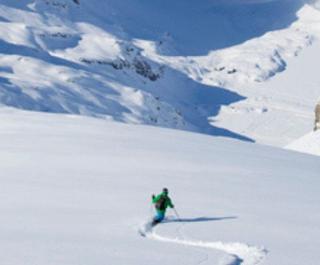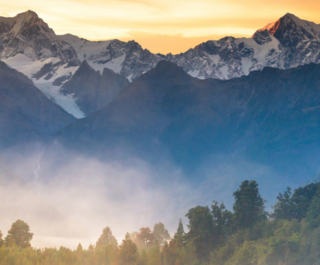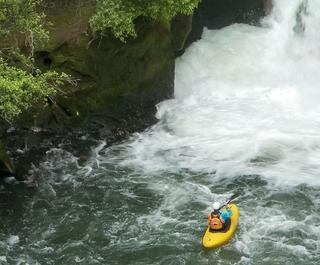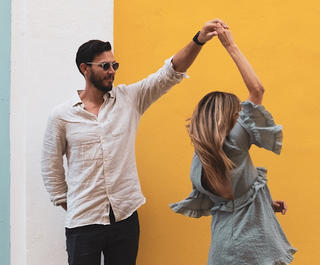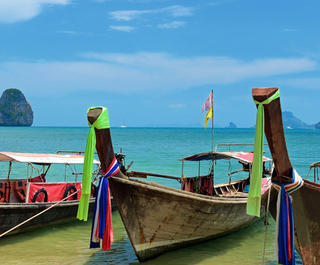
Starlight was skittering across the waves and a few giant fruit bats were heading towards the middle of the island. Moses and Tony, my local guides, looked at me expectantly. I had to decide where to go. I resisted the desire to say: “Let’s just stay here. I can snorkel the reef and photograph the hummingbirds at my hut window.” Why go anywhere?
I had travelled to the other side of the globe, to the remotest spot imaginable, and now, having arrived in darkness at a surprisingly comfortable back country surfer retreat, I was planning to leave at dawn.
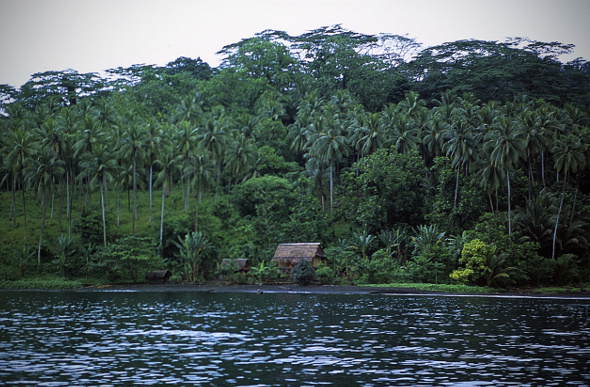 A lone beachfront house on an island in Papua New Guinea (Getty)
A lone beachfront house on an island in Papua New Guinea (Getty)
I shone the torch on the map. Maps are the root of all restlessness, if you ask me, especially when you have a blue sea spangled with constellations of islands, reefs and wrecks, plus a pair of kayaks waiting on the beach.
On that map, Papua New Guinea looked like a giant warthog charging towards the Pacific, tossing bones ahead of it. One of those bones, 965 kilometres east of the warthog’s snout, is New Ireland.
With a battered index finger, Moses pointed out Nusa Island, a tiny atoll off its northern tip. “That’s where we are now.”
.........................................................................................................................................................
Island Of Ghosts At The End Of The World
.........................................................................................................................................................
Beyond it, in a northward arc, was a string of islands: the Tigak archipelago.
For a long time, Papua New Guinea has been the explorer’s paradise, unknown and unvisited, but now it’s rapidly opening up to less intrepid visitors.
My trip had involved some long flights, but getting to these islands had not been difficult. Moses had met me off the small plane at Kavieng airstrip, then ferried me across to Nusa Island where I’d been pleasantly surprised to find the well-organised and comfortable Nusa Island Retreat.
Now I followed Moses’s finger as he pointed. “Good snorkelling here. Nice island, that one. Place to sleep here.”
 Pacific paddling … Moses sets off. Photograph: Kevin Rushby
Pacific paddling … Moses sets off. Photograph: Kevin Rushby
His finger stopped at a larger island, Tsoilik, an oval bisected by a curving creek. “Finish here.”
But my eye carried on along the crooked line of the reef to one more island – the island at the end of the world.
“What’s this one?”
Tony laughed uneasily. “That’s Nemto. Let’s not go there. It’s a bad place, full of ghosts.”
But Moses was from the Papua New Guinea highlands: the ghosts of Nemto didn’t bother him. He measured out the route in paddling sessions and overnight stops. “If you and me paddle out and Tony fetches us in the motorboat, we can do it.”
.........................................................................................................................................................
Grisly Heritage Of A Bloody Conflict
.........................................................................................................................................................
This is why I had come. Adventure was close, easily accessible. I stopped thinking about lounging in a hammock.
At dawn, I was woken by the voices of women preparing breakfast for me and the other guests at the retreat. Moses was already sorting out kayak equipment on the beach.
In the channel, a Chinese logging ship was sliding away to the north-west, a reminder that global events do impinge even this remote area.
During the second world war, battles raged here, leaving a grisly heritage in submarine and jungle-covered relics, now a big attraction for visitors.
Moses threw a couple of diving masks into the pile of gear. “We can try and find the Japanese warplane,” he said. “There’s one near the old leper colony on Anelaua.”
 Moses surveys the territory
Moses surveys the territory
Having made our rendezvous plans with Tony, we set out.
It was a windless day with a thin veiling of cloud, which I didn’t mind at all. We skirted Nusa then set a course towards Nubils, our first night’s stop.
Dolphins cut across our bows and a turtle popped up to take a look.
By lunchtime, we had reached a deserted, jungle-covered island, where we swam off the reef. I was struck by the quantity and quality of soft corals waving in the currents, each inhabited by an orange clown fish.
Further out, the creatures became more deadly: a lion fish drifted along and, in the gloom, a gang of sharks.
Reaching Nubils that afternoon, we worked our way around the jungle shore to a small sheltered beach where our host, Gordon, was sitting on a log mending a fishing net.
“There is the bathroom,” he said, pointing down the beach, “and this is your house.” He pointed the other way to a stilted hut made of logs and palm leaves.
 Japanese Second World War plane off Anelaua Island.
Japanese Second World War plane off Anelaua Island.
Darkness fell abruptly with an immense stillness on the water. Gordon lit a lamp and produced our dinner: a soup of papaya and mangrove snails followed by some small scarlet fried fish with sago, a wild tree that is felled and gutted for its starchy interior (and fed to dismayed mid-20th-Century British schoolchildren).
Check some more travel adventures. 4 Remarkable Adventure Travel Experiences
See more of PNG's natural wonders. Top Natural Attractions in Papua New Guinea
.........................................................................................................................................................
Loud Rock Music On An Isolated Beach
.........................................................................................................................................................
Despite my low expectations, it was all delicious. I went to bed, fell asleep and woke an hour later to booming rock music. I stumbled down to the beach and found a battered old radio blaring. Gordon and Moses were both asleep.
When I turned the music off, they woke up. I convinced them to keep it off, then went back to bed.
Soon after dawn, we were on our way again, paddling via a delightful atoll inhabited only by birds, to Anelaua, the former leper colony island. The wind had risen and there were choppy waves coming in now, but I slipped into the water with a face mask and set out to find the plane wreck.
Visibility was poor and the tide had come in, making the water so deep that I could just get down, take a quick look, then swim up.
I was almost ready to give up when suddenly it was there, right under me: a complete aircraft. It was a two-seater, single-engined plane: the cockpit was full of small fish and a large yellow coral was blooming on the fuselage. After three dives, I could do no more and headed back to the kayaks.
We had a big paddle ahead and squalls of rain were dodging around us as we left Anelaua.
Our objective was a narrow creek between two islands, where a handful of palm-thatch huts sat on a narrow strip of white sand and a clutch of outrigger canoes were drawn up.
After a dinner of huge crabs, we sat under a thatch shelter and our host, an old lady called Oliparanis, proceeded to tell us about the giant sea snake Tunga Tunga Kang who lived up a narrow creek opposite.
This monster was a masali, a spirit creature, who was a totem animal for a local clan.
 Hunting fruit bats on Nusa island
Hunting fruit bats on Nusa island
“What about the masali on Nemto?”
She shuddered. “That one is very bad.”
Next morning, we set out late and paddled all day along the islands to the north of Tsoilik, where we found a small creek and a guesthouse run by a lady called Rutu. Her visitors’ book showed that only a few travellers had made it this far – ridiculous for such an idyllic spot.
Next day, Tony arrived in the motorboat and we discussed the weather.
Big swells were slapping over the reef and Nemto looked a long way off. “Better we use the motor,” said Tony. “Then we can take Manu, Rutu’s son – he knows the way through the reef.”
We set off, Manu guiding us out into the ocean and past the wreckage of a 1940s Japanese warship.
An hour or so later, we reached Nemto and, passing through a narrow gap in the breakers, crossed the lagoon and ran up on the jungle-backed beach.
“There is one man, Ansalem, who lives here with his wife,” said Manu. “You can go and meet them.”
 Ansalem walking on Nemto. He and his wife are the island's only inhabitants.
Ansalem walking on Nemto. He and his wife are the island's only inhabitants.
We walked along the shore, dodging under giant tree boughs that had come to rest on the sand. Each was laden with orchids and other epiphytic plants.
.........................................................................................................................................................
Repulsed By The Stench Of A Rotting Sperm Whale
.........................................................................................................................................................
We came across the rotting carcass of a washed-up sperm whale, which was slowly disintegrating to reveal the massive skull. I tried to lift its giant lip with a stout stick, searching for its precious teeth, but was beaten back by the stench.
We found Ansalem sitting on a fallen log smoking home-grown tobacco in a twist of newspaper. He was, I guessed, around 60, barefoot and dressed in an old sarong.
On the log beside him was a handmade string bag for his tobacco and betel nuts. He looked extremely fit. His wife was down on the beach, sorting out the fish he had caught that morning.
I asked why he had moved here. “I came here because my home island, Lukus, was too crowded.”
“Weren’t you afraid?”
He laughed. “There is a masali here, a giant snake with a man’s head, but he never bothers me. My great grandfather had the power to see the masali, even to talk with it. He could change shape, too: sometimes he would turn himself into a pig and run through the jungle!”
“Would you go back to Lukus?”
“Never!” he scoffed. “Look at me. I eat fresh fish and crabs every day. There’s fruit from the forest and I drink coconut water when I’m thirsty.”
 Ansalem: “Look at me. I eat fresh fish every day, fruit from the forest and drink coconut water when I’m thirsty.”
Ansalem: “Look at me. I eat fresh fish every day, fruit from the forest and drink coconut water when I’m thirsty.”
“Don’t you miss people?”
“Fishermen come here. I talk to them. I exchange dried fish for things I want – rice, salt and soap.”
Later, Ansalem and I took an hour to walk the whole way around his island sanctuary. He pointed out turtle nests and hidden springs where coral trout came in to spawn.
“In the trees here,” he said at the far northern tip of the island, “are the graves of the Kotkot people, who lived here long ago. They all died of a disease carried by rats.”
So here was the probable explanation of Nemto’s ghostly reputation: it had been abandoned after a plague that came with European explorers in the 17th century – outsiders who stumbled into this idyll and destroyed it.
Arriving back at our boat, we sat in the sand and shared our food. Tony had brought some white-bread sandwiches and an alarmingly colourful powdered drink; Ansalem provided fried fish and green coconuts. His offerings were the tastier, and he didn’t touch ours.
When we came to leave, I wanted to give him a present, but nothing in my bag seemed remotely useful for a self-sufficient castaway, so I gave him some cash. He seemed pleased. “I’ll buy a cloth for my wife from the fishermen.”
 Girl on an outrigger canoe on Anelaua island
Girl on an outrigger canoe on Anelaua island
From the boat, I watched Ansalem and his wife strolling along the beach to their cabin, two ageing Robinson Crusoes chatting, string bags thrown casually over their shoulders. They had, apparently, forgotten about us already.
This article originally appeared on guardian.co.uk
This article was written by Kevin Rushby from The Guardian and was legally licensed through the NewsCred publisher network.


